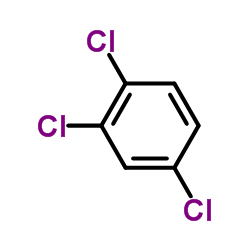1,2,4-Trichlorobenzene

1,2,4-Trichlorobenzene structure
|
Common Name | 1,2,4-Trichlorobenzene | ||
|---|---|---|---|---|
| CAS Number | 120-82-1 | Molecular Weight | 181.447 | |
| Density | 1.4±0.1 g/cm3 | Boiling Point | 211.4±20.0 °C at 760 mmHg | |
| Molecular Formula | C6H3Cl3 | Melting Point | 16 °C(lit.) | |
| MSDS | Chinese USA | Flash Point | 126.7±0.0 °C | |
| Symbol |


GHS07, GHS09 |
Signal Word | Warning | |
|
QSPR modeling of octanol/water partition coefficient for vitamins by optimal descriptors calculated with SMILES.
Eur. J. Med. Chem. 43 , 714-40, (2008) Simplified molecular input line entry system (SMILES) has been utilized in constructing quantitative structure-property relationships (QSPR) for octanol/water partition coefficient of vitamins and organic compounds of different classes by optimal descriptors.... |
|
|
Understanding Solidification of Polythiophene Thin Films during Spin-Coating: Effects of Spin-Coating Time and Processing Additives.
Sci. Rep. 5 , 13288, (2015) Spin-coating has been used extensively in the fabrication of electronic devices; however, the effects of the processing parameters have not been fully explored. Here, we systematically characterize the effects of the spin-coating time on the microstructure ev... |
|
|
Development of a partition-controlled dosing system for cell assays.
Chem. Res. Toxicol. 23(11) , 1806-14, (2010) Hydrophobic and volatile chemicals have proven to be difficult to dose in cell assays. Cosolvents are often needed to dissolve these chemicals in cell culture medium. Moreover, the free concentration of these chemicals in culture medium may diminish over time... |
|
|
[Cloning and quantitative expression of chlorocatechol 1,2-dioxygenase gene].
Huan Jing Ke Xue 30(2) , 606-9, (2009) The chlorocatechol 1,2-dioxygenase gene, designated as tcbC (J5-2) (GenBank Accession No. EF111021), was cloned from total DNA of Pseudomonas aeruginosa J5-2 which can degrade 1,2,4-trichlorobenzene. The deduced amino acid sequence analysis of tcbC (JS-2) sho... |
|
|
Concentrations of selected organochlorines and chlorobenzenes in the serum of former Love Canal residents, Niagara Falls, New York.
Environ. Res. 110(3) , 220-5, (2010) Love Canal, in Niagara Falls, NY is among the earliest and most significant hazardous waste sites in the USA, but no study has ever measured chemical body burdens in nearby residents to document that human exposure occurred. This study measured concentrations... |
|
|
Optimizations of packed sorbent and inlet temperature for large volume-direct aqueous injection-gas chromatography to determine high boiling volatile organic compounds in water.
J. Chromatogr. A. 1356 , 221-9, (2014) For the expanded application area, fast trace analysis of certain high boiling point (i.e., 150-250 °C) volatile organic compounds (HVOCs) in water, a large volume-direct aqueous injection-gas chromatography (LV-DAI-GC) method was optimized for the following ... |
|
|
Determination of chlorobenzenes in water samples by solid-phase disk extraction and gas chromatography-electron capture detection.
J. Chromatogr. Sci. 52(5) , 375-82, (2014) A simple, rapid, sensitive and high throughput method is described, based on solid-phase disk extraction (SPDE) and gas chromatography-electron capture detection, for the determination of chlorobenzens (CBs) in water samples. The proposed SPDE sample pretreat... |
|
|
Environmental contaminants activate human and polar bear (Ursus maritimus) pregnane X receptors (PXR, NR1I2) differently.
Toxicol. Appl. Pharmacol. 284(1) , 54-64, (2015) Many persistent organic pollutants (POPs) accumulate readily in polar bears because of their position as apex predators in Arctic food webs. The pregnane X receptor (PXR, formally NR1I2, here proposed to be named promiscuous xenobiotic receptor) is a xenobiot... |
|
|
The lin genes for γ-hexachlorocyclohexane degradation in Sphingomonas sp. MM-1 proved to be dispersed across multiple plasmids.
Biosci. Biotechnol. Biochem. 75(3) , 466-72, (2011) A γ-hexachlorocyclohexane (HCH)-degrading bacterium, Sphingomonas sp. MM-1, was isolated from soil contaminated with HCH isomers. Cultivation of MM-1 in the presence of γ-HCH led to the detection of five γ-HCH metabolites, γ-pentachlorocyclohexene, 2,5-dichlo... |
|
|
Biological responses of maize (Zea mays) plants exposed to chlorobenzenes. Case study of monochloro-, 1,4-dichloro- and 1,2,4-trichloro-benzenes.
Ecotoxicology 21(2) , 315-24, (2012) A 7-day-exposure time experiment was designed to investigate the phytotoxicity of chlorobenzenes (CBs) on Zea mays seedlings, focusing on the growth and generation of oxidative stress. Significant growth inhibition (based on biomass gain) was observed for exp... |